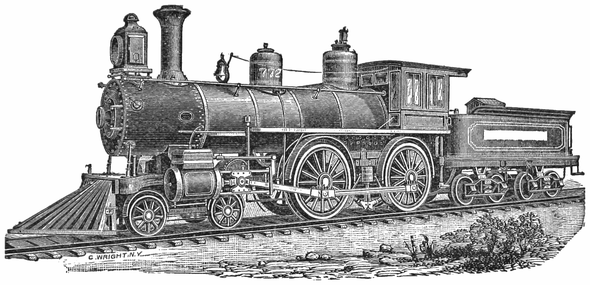Transcriber’s Note
Cover created by Transcriber and placed in the Public Domain.
Some large diagrams (such as Fig. 12)may be reduced in size to fit your screen. In most browsers, youcan see a larger, more detailed version of such an image by enlarging thewindow or right-clicking the image and selecting "open image" or"view image" (wording varies by browser). If the Browser then shows amagnifying glass, clicking again will show the image full-size.
On some eReaders, stretching and/or double-tapping animage will magnify it and show more detail, including better readability ofsmall print.

LOCOMOTIVE ENGINE
RUNNING AND MANAGEMENT:
A Treatise on Locomotive Engines,
SHOWING THEIR PERFORMANCE IN RUNNING DIFFERENT
KINDS OF TRAINS WITH ECONOMY AND DISPATCH;
ALSO DIRECTIONS REGARDING THE CARE,
MANAGEMENT, AND REPAIRS OF
LOCOMOTIVES AND ALL
THEIR CONNECTIONS.
BY
ANGUS SINCLAIR,
MEMBER OF THE BROTHERHOOD OF LOCOMOTIVE ENGINEERS, MEMBER OF THE
AMERICAN SOCIETY OF MECHANICAL ENGINEERS, ASSOCIATE MEMBER
OF THE AMERICAN RAILWAY MASTER MECHANICS’ ASSOCIATION,
ASSOCIATE MEMBER OF THE UNITED
STATES NAVAL INSTITUTE, ETC.
TENTH EDITION.
NEW YORK:
JOHN WILEY AND SONS.
1888.
Copyright, 1884,
By JOHN WILEY & SONS.
ELECTROTYPED AND PRINTED
BY RAND, AVERY, AND COMPANY,
BOSTON, MASS.
While following the occupation of a locomotiveengineer, I often observed peculiarities about theworking of my engine, while running, that I did notentirely understand. As I was perfectly aware, evenbefore making my first trip on a locomotive engine,that there is no effect without a cause, I never feltsatisfied to accept any thing as incomprehensiblewithout investigation, and fell into the habit of notingdown facts about the working of the engine, with theview of studying out, at leisure, any thing which wasnot quite clear. When, some years ago, I abandonedengine-running to take charge of the round-house atthe mechanical headquarters of the Burlington, CedarRapids, and Northern Railway, in Iowa, the practiceof keeping notes was continued. The work connectedwith the ordinary repairing of running-engines, theemergency repairing executed to get engines readyhurriedly to meet the traffic demands on a road thenchronically short of power, and diagnosing the numerousivdiseases that locomotives are heir to, providedample material for voluminous notes. Those notesformed the raw material from which this book wasconstructed.
The original intention was, to publish a book onLocomotive Engine Running alone, and the first portionof the work was prepared with that idea in view;but, before the articles were finished, I joined theeditorial staff of the American Machinist. The correspondencein the office of that paper convinced methat an urgent dem